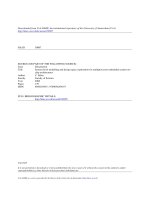computing system reliability models and analysis (cell engineering)
Bạn đang xem bản rút gọn của tài liệu. Xem và tải ngay bản đầy đủ của tài liệu tại đây (7.49 MB, 308 trang )
Computing System Reliability
Models and Analysis
This page intentionally left blank
Computing System Reliability
Models and Analysis
Min Xie
Yuan-Shun Dai
and
Kim-Leng Poh
National University of Singapore
Singapore
KLUWER ACADEMIC PUBLISHERS
NEW YORK, BOSTON, DORDRECHT, LONDON, MOSCOW
eBook ISBN: 0-306-48636-9
Print ISBN: 0-306-48496-X
©2004 Kluwer Academic Publishers
New York, Boston, Dordrecht, London, Moscow
Print ©2004 Kluwer Academic/Plenum Publishers
New York
All rights reserved
No part of this eBook may be reproduced or transmitted in any form or by any means, electronic,
mechanical, recording, or otherwise, without written consent from the Publisher
Created in the United States of America
Visit Kluwer Online at:
and Kluwer's eBookstore at:
Preface
Computing systems are widely used today and in many areas they serve the key
function in achieving highly complicated and safety-critical mission. At the
same time, the size and complexity of computing systems have continued to
increase, making its performance evaluation more difficult than ever before.
The purpose of this book is to provide a comprehensive coverage of tools
and techniques for computing system reliability modeling and analysis.
Reliability analysis is a useful tool in evaluating the performance of complex
systems. Intensive studies have been carried out to improve the likelihood for
computing systems to perform satisfactorily in operation.
Software and hardware are two major building blocks in computing systems.
They have to work together successfully to complete many critical computing
tasks. This book systematically studies the reliability of software, hardware and
integrated software/hardware systems. It also introduces typical models in the
reliability analysis of the distributed/networked systems, and then further
develops some new models and analytical tools.
“Grid” computing system has emerged as an important new field,
distinguished from conventional distributed computing systems by its focus on
large-scale resource sharing, innovative applications, and, in many cases, high-
performance orientation. This book also presents general reliability models for
the grid and discusses analytical tools to estimate the grid reliability related to
the resource management system, wide-area network communication, and
parallel running programs with multiple shared resources.
v
vi
Computing System Reliability
Furthermore, this book introduces the basic reliability theories and models
for various multi-state systems. Based on the models, some interesting decision
problems in system design and resource allocation are further discussed.
This book is organized as follows.
Chapter 1 provides an introduction to the field of computing systems and
reliability analysis. Simple reliability concepts are also discussed. Chapter 2
provides the basic knowledge in reliability analysis and summarizes some
common techniques for analyzing the computing system reliability. The
fundamentals of Markov processes and Nonhomogeneous Poisson processes
(NHPP) are also introduced, which are essential tools used in this book.
Chapters 3 and 4 present important models for the reliability analysis of
hardware and software systems, respectively. They are useful when hardware
and software issues are dealt with separately at the system analysis stage.
Chapter 5 discusses the models for integrated systems. This is essential in
computing system analysis as both software and hardware systems have to work
together.
In Chapter 6, the reliability of various distributed computing systems
which incorporate the network communication into the hardware/software
reliability is studied. The distributed computing system is a common and
widely-used networked system and hence a chapter is devoted to this.
The reliability of grid computing systems, which is a new direction in
computing technology, is studied in Chapter 7. Since the grid reliability is
difficult to evaluate due to its wide-area, heterogeneous and time various
characteristics, we initially construct the reliability models for the different parts
of the grid, including resource management system, large-scale network,
distributed software and resources.
Finally, Chapter 8 studies the multi-state system reliability. Some
optimization models in the system design and resource allocation are presented
in Chapter 9. This is an area where research is going on and further development
is needed.
Preface
vii
The basic chapters in this book are Chapters 3-7. Readers familiar with
basic reliability can start from Chapter 3 directly. Chapters 8 and 9 are on
advanced topics and can be read by those interested in those specific topics.
Many models and results found in the literature and from our research are
presented in the book. It is hoped that these approaches are easily implemented
by practitioners as well. In addition, many examples are accompanied with those
approaches.
The book serves as reference book for students, professors, engineers and
researchers in related science and engineering field. It can be used for graduate
and senior undergraduate courses. Researchers and students should find many
ideas useful in their academic work.
The readers should have some basic knowledge in probability and calculus.
However, difficult details are omitted to benefit the general audience.
References are given so that further details can be found for those who are
interested in more specific results.
M. Xie
Y. S.
Dai
K. L.
Poh
This page intentionally left blank
Acknowledgements
This book has evolved over the past ten years. We would like to thank our
collaborators and students who have worked on one or more topics covered in
the book. Especially, G. Y. Hong, B. Yang, S. L. Ho and G. Q. Liu have
contributed a significant amount to the work presented in the book.
We are fortunate to have worked closely with many overseas colleagues,
such as L. R. Cui, O. Gaudoin, P. K. Kapur, C. D. Lai, G. Levitin,
D. N. P. Murthy, K. Way, C. Wohlin, M. Zhao, among others. This has helped
broaden our view which is needed for a book as such. Many people worldwide
have been interested in our work and we are grateful to T. Dohi, K. Kanoun,
T. Khoshgoftaar, S. Y. Kuo, M. R. Lyu, J. Musa, S. Osaki, H. Pham,
N. Schneidewind, Y. Tohma, K. S. Trivedi, M. Vouk, L. Walls, S. Yamada,
M. J. Zuo and others for their help in our research.
Our research is supported by the National University of Singapore. We are
also grateful to all staff and other students in the Department of Industrial and
Systems Engineering for their help in one way or another.
The effort of Gary Folven of Kluwer and other staff at the Kluwer
Academic Publisher is also appreciated. The idea of putting together this book
was firmed up after his trip to Singapore at the beginning of the millennium.
Finally, we would like to thank our families for their understanding and
support in all these years.
ix
This page intentionally left blank
Contents
1
INTRODUCTION
1
1.1.
Need for Computing System Reliability Analysis
1
1.2.
Computing System Reliability Concepts
2
1.3.
Approaches to Computing System Modeling
3
2
BASIC RELIABILITY CONCEPTS AND ANALYSIS
7
2.1. Reliability Measures
7
2.2.
Common Techniques in Reliability Analysis
12
2.3.
Markov Process Fundamentals
19
2.4.
Nonhomogeneous Poisson Process (NHPP) Models
36
3
MODELS FOR HARDWARE SYSTEM RELIABILITY
41
3.1.
Single Component System
41
3.2.
Parallel Configurations
48
3.3.
Load-Sharing Configurations
58
3.4.
Standby Configurations
61
3.5.
Notes and References
69
4
MODELS FOR SOFTWARE RELIABILITY
71
4.1.
Basic Markov Model
71
xi
xii
Computing System Reliability
4.2.
Extended Markov Models
76
4.3.
Modular Software Systems
90
4.4.
Models for Correlated Failures
94
4.5.
Software NHPP Models
101
4.6.
Notes and References
110
5
MODELS FOR INTEGRATED SYSTEMS
113
5.1. Single-Processor System
113
5.2.
Models for Modular System
122
5.3.
Models for Clustered System
128
5.4.
A Unified NHPP Markov Model
139
5.5.
Notes and References
143
6
AVAILABILITY AND RELIABILITY OF DISTRIBUTED
COMPUTING SYSTEMS
145
6.1.
Introduction to Distributed Computing
146
6.2.
Distributed Program and System Reliability
148
6.3.
Homogeneously Distributed Software/Hardware Systems
163
6.4.
Centralized Heterogeneous Distributed Systems
171
6.5.
Notes and References
176
7
RELIABILITY OF GRID COMPUTING SYSTEMS
179
7.1.
Introduction of the Grid Computing System
180
7.2.
Grid Reliability of the Resource Management System
184
7.3.
Grid Reliability of the Network
188
7.4.
Grid Reliability of the Software and Resources
201
7.5.
Notes and References
204
Contents
xiii
8
MULTI-STATE SYSTEM RELIABILITY
207
8.1.
Basic Concepts of Multi-State System (MSS)
207
8.2.
Basic Models for MSS Reliability
214
8.3.
A MSS Failure Correlation Model
224
8.4.
Notes and References
236
9
OPTIMAL SYSTEM DESIGN AND RESOURCE
ALLOCATION
239
9.1. Optimal Number of Hosts
240
9.2.
Resource Allocation - Independent Modules
247
9.3.
Resource Allocation - Dependent Modules
258
9.4.
Optimal Design of the Grid Architecture
266
9.5.
Optimal Integration of the Grid Services
269
9.6.
Notes and References
272
References
275
Subject Index
291
This page intentionally left blank
CHAPTER
INTRODUCTION
1.1.
Need for Computing System Reliability Analysis
Computing has been the fastest developing technology during the last century.
Computing systems are widely used in many areas, and they are desired to
achieve various complex and safety-critical missions. The applications of the
computing systems have now crossed many different fields and can be found in
different products, for example, air traffic control systems, nuclear power
plants, aircrafts, real-time military systems, telephone switching, bank
auto-payment, hospital patient monitoring systems, and so forth.
The size and complexity of the computing systems has increased from one
single processor to multiple distributed processors, from individual-separated
systems to networked-integrated systems, from small-scale program running to
large-scale resource sharing, and from local-area computation to global-area
collaboration. A computing system today may contain many processors and
communication channels and it may cover a wide area all over the world. They
combine both software and hardware that have to function together to complete
1
2
Introduction
various tasks. They may incorporate multiple states and their failures may be
correlated with one another. These factors make the system modeling and
analysis complicated. As a result, making decisions in the system design or
resource allocation also becomes difficult accordingly.
There is no common approach to assess computing systems. Reliability is a
quantitative measure useful in this context as reliability can be broadly
interpreted as the ability for a system to perform its intended function. Intensive
studies on reliability models and analytical tools are carried out to improve the
chance that the computing systems will perform satisfactorily in operations. As
the functionality of computing operations becomes more essential, there is a
greater need for a high reliability of the computing systems.
In fact, in order to increase the performance of the computing systems and
to improve the development process, a thorough analysis of their reliability is
needed. Based on the models and analysis, approaches to improve system
reliability can be further implemented.
1.2.
Computing System Reliability Concepts
In general, the basic reliability concept is defined as the probability that a
system will perform its intended function during a period of running time
without any failure (Musa, 1998). A failure causes the system performance to
deviate from the specified performance.
A fault is an erroneous state of the system. Although the definitions of fault
are different for different systems and in different situations, a fault is always
an existing part in the system and it can be removed by correcting the erroneous
part of the system. For the computing systems, the basic reliability concept can
be adapted to some specific forms such as “software reliability”, “system
reliability”, “service reliability”, “system availability”, etc., for different
purposes.
3
Computing System Reliability Analysis
Most computing systems contain software programs to achieve various
computing tasks. Software reliability is an important metric to assess the
software performance. Similar to the general reliability concept, software
reliability is defined as the probability that the software will be functioning
without failure under a given environmental condition during a specified period
of time (Xie, 1991). Here, a software failure means generally the inability of
performing an intended task specified by the requirement.
Software reliability is only a measurement of software program. In order to
assess the computing system that may contain multiple software programs and
hardware components, system reliability is commonly used. It is defined as the
probability that all the tasks for which the system is desired can be successfully
completed (Kumar et al., 1986). Those software programs may be in parallel or
serial and they may even have any arbitrarily distributed structure. The system
reliability needs to be computed in a different way according to the system
structure.
Some computing systems are developed to provide different services for
the users. The users may only be concerned with whether the service they are
using is reliable or not. From the users’ point of view, service reliability is an
important measure, and it is defined as the probability for a given service to be
achieved successfully. This is a useful concept in service quality analysis, and it
broadens the traditional reliability definition.
1.3.
Approaches to Computing System Modeling
Computing system reliability is an interesting, but difficult, research area.
Although there are many reliability models suggested and studied in the
literature, none can be used universally, and there is no unique model which
can perform well in all situations. The reason for this is that the assumptions
made for each model are correct or are good approximations of the reality only
in specific cases.
4
Introduction
In the computing systems, hardware (such as computers, routers,
processors, CPUs, memories, disks, etc.) provides the fundamental
configurations to support computing tasks. Many traditional reliability models
mainly dealt with the hardware reliability, such as Barlow & Proschan (1981),
Elsayed (1996) and Blishcke & Murthy (2000).
Software is another important element in the computing systems besides
the hardware. Different from the hardware, the software does not wear-out and
it can be easily reproduced. Furthermore, software systems are usually
debugged during testing phase so that its reliability is improving over time.
Many software reliability models have been proposed for the study of software
reliability, see e.g., Xie (1991), Lyu (1996), Musa (1998) and Pham (2000).
However, a computing system usually includes not only a hardware
subsystem but also a software subsystem, which ought not to be separately
studied. Both software and hardware failures should be integrated together in
analyzing the performance of the whole system. Many reliability models for the
integrated software and hardware systems have been recently presented, such
as Goel & Soenjoto (1981), Siegrist (1988), Laprie & Kanoun (1992), Dugan &
Lyu, (1994), Welke et al., (1995) and Lai et al. (2002). Although there are some
books that contain discussion on integrated software and hardware system
reliability, this book is entirely devoted to this topic and the associated issues.
Accompanying the development of network techniques, many computing
systems need to communicate information through the (local or global)
networks. The programs and resources of such systems are distributed all over
the different sites connected by the networks. This kind of computing system is
usually called distributed computing system. The performance of a distributed
computing system is determined not only by the software/hardware reliability
but also by the reliability of the networks for communication. Many models
and algorithms have been presented for the distributed system reliability, see
5
Computing System Reliability Analysis
e.g. Hariri et al. (1985), Kumar et al. (1986), Chen & Huang (1992), Chen et
al. (1997), Lin et al. (1999, 2001) and Dai et al. (2003a).
As a special type of the distributed computing systems, grid computing is a
recently developed technique by its focus on various shared resources,
large-scale networks, wide-area communications, real-time programs, diverse
virtual organizations, heterogeneous platforms etc. Many experts believe that
the grid computing systems and technologies will offer a second chance to
fulfill the promises of the Internet, see e.g. Foster & Kesselman (1998).
Although it is difficult to study due to its complexity, the reliability of the grid
computing systems begins to be of concern today.
Most of reliability models for computing systems assume only two
possible states of the system. In reality, many computing systems may contain
more than two states (Lisnianski & Levitin, 2003), especially for those
real-time systems. For example, if some computing elements in a real-time
system fail, the system may still continue working but its performance should
be degraded. Such a degradation state is another state between the perfect
working and completely failed states. To study these types of systems, the
Multi-State system reliability is also of concern recently to many researchers,
e.g. Brunelle & Kapur (1999), Pourret et al. (1999), Levitin et al. (2003) and
Wu & Chan (2003).
The book provides a systematic and comprehensive study of different
reliability models and analytical tools for various computing systems including
hardware, software, integrated software/hardware, distributed computing, grid
computing, multi-state systems etc. Some interesting optimization problems for
system design and resource allocation are further discussed. Many examples
are used to illustrate to the use of these models.
This page intentionally left blank
CHAPTER
BASIC RELIABILITY
CONCEPTS AND ANALYSIS
Reliability concepts and analytical techniques are the foundation of this book.
Many books dealing with general and specific issues of reliability are available,
see e.g., Barlow & Proschan (1981), Shooman (1990), Hoyland & Rausand
(1994), Elsayed (1996), and Blischke & Murthy (2000). Some basic and
important reliability measures are introduced in this chapter. Since computing
system reliability is related to general system reliability, the focus will be on tools
and techniques for system reliability modeling and analysis. Since Markov
models will be extensively used in this book, this chapter also introduces the
fundamentals of Markov modeling. Moreover, Nonhomogeneous Poisson Process
(NHPP) is widely used in reliability analysis, especially for repairable systems.
Its general theory is also introduced for the reference.
2.1. Reliability Measures
Reliability is the analysis of failures, their causes and consequences. It is the most
important characteristic of product quality as things have to be working
satisfactorily before considering other quality attributes. Usually, specific
7
8
Basic Reliability Concepts
performance measures can be embedded into reliability analysis by the fact that if
the performance is below a certain level, a failure can be said to have occurred.
2.1.1.
Definition of reliability
The commonly used definition of reliability is the following.
Definition 2.1. Reliability is the probability that the system will perform its
intended function under specified working condition for a specified period of
time.
Mathematically, the reliability function R(t) is the probability that a system will
be successfully operating without failure in the interval from time 0 to time t,
where T is a random variable representing the failure time or time-to-failure.
The failure probability, or unreliability, is then
which is known as the distribution function of T.
If the time-to-failure random variable T has a density function f (t), then
The density function can be mathematically described as
This can be interpreted as the probability that the failure
time T will occur between time t and the next interval of operation, The
three functions, R(t), F(t) and f(t) are closely related to one another. If any of
them is known, all the others can be determined.
9
Computing System Reliability
2.1.2.
Mean time to failure (MTTF)
Usually we are interested in the expected time to next failure, and this is termed
mean time to failure.
Definition 2.2.
The
mean time to failure (MTTF)
is defined as the expected value
of the lifetime before a failure occurs.
Suppose that the reliability function for a system is given by
R
(
t
)
,
the MTTF
can be computed as
Example 2.1.
If the lifetime distribution function follows an exponential
distribution with parameter
that is,
the MTTF is
This is an important result as for exponential distribution. MTTF is related to a
single model parameter in this case. Hence, if MTTF is known, the distribution is
specified.
2.1.3.
Failure rate function
The failure rate function, or hazard function, is very important in reliability
analysis because it specifies the rate of the system aging. The definition of failure
rate function is given here.
Definition 2.3.
The
failure rate function
is defined as
10
Basic Reliability Concepts
The quantity represents the probability that a device of age
t
will fail in
the small interval from time t to t + dt. The importance of the failure rate
function is that it indicates the changing rate in the aging behavior over the life of
a population of components. For example, two designs may provide the same
reliability at a specific point in time, but the failure rate curves can be very
different.
Example 2.2. If the failure distribution function follows an exponential
distribution with parameter
then the failure rate function is
This means that the failure rate function of the exponential distribution is a
constant. In this case, the system does not have any aging property. This
assumption is usually valid for software systems. However, for hardware
systems, the failure rate could have other shapes.
2.1.4.
Maintainability and availability
When a system fails to perform satisfactorily, repair is normally carried out to
locate and correct the fault. The system is restored to operational effectiveness by
making an adjustment or by replacing a component.





![firewall design and analysis [electronic resource]](https://media.store123doc.com/images/document/14/y/zf/medium_zfb1401470806.jpg)



